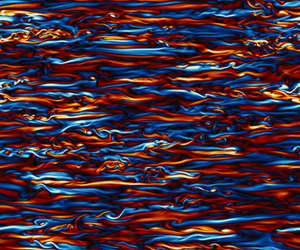Published online by Cambridge University Press: 21 September 2020

Stratified turbulence has a horizontally layered structure with quasi-two-dimensional vortices due to buoyancy forces that suppress vertical motion. The Prandtl number  $\textit {Pr}$ quantifies the relative strengths of viscosity and buoyancy diffusivity, which damp small-scale velocity and buoyancy fluctuations at different microscales. Direct numerical simulations (DNS) require high resolution to resolve the smallest flow features for large
$\textit {Pr}$ quantifies the relative strengths of viscosity and buoyancy diffusivity, which damp small-scale velocity and buoyancy fluctuations at different microscales. Direct numerical simulations (DNS) require high resolution to resolve the smallest flow features for large  $\textit {Pr}$. To reduce computational demand,
$\textit {Pr}$. To reduce computational demand,  $\textit {Pr}$ is often set to 1. In this paper, we explore how varying
$\textit {Pr}$ is often set to 1. In this paper, we explore how varying  $\textit {Pr}$ affects stratified turbulence. DNS of homogeneous forced stratified turbulence with
$\textit {Pr}$ affects stratified turbulence. DNS of homogeneous forced stratified turbulence with  $0.7 \le \textit {Pr} \le 8$ are performed for four stratification strengths and buoyancy Reynolds numbers
$0.7 \le \textit {Pr} \le 8$ are performed for four stratification strengths and buoyancy Reynolds numbers  $\textit {Re}_b$ between 0.5 and 60. Energy spectra, buoyancy flux spectra, spectral energy flux and physical space fields are compared for scale-specific
$\textit {Re}_b$ between 0.5 and 60. Energy spectra, buoyancy flux spectra, spectral energy flux and physical space fields are compared for scale-specific  $\textit {Pr}$-sensitivity. For
$\textit {Pr}$-sensitivity. For  $\textit {Re}_b \gtrsim 10$,
$\textit {Re}_b \gtrsim 10$,  $\textit {Pr}$-dependence in the kinetic energy is mainly found at scales around and below the Kolmogorov scale. The potential energy and flux exhibit more prominent
$\textit {Pr}$-dependence in the kinetic energy is mainly found at scales around and below the Kolmogorov scale. The potential energy and flux exhibit more prominent  $\textit {Pr}$-sensitivity. As
$\textit {Pr}$-sensitivity. As  $\textit {Re}_b$ decreases, this
$\textit {Re}_b$ decreases, this  $\textit {Pr}$-dependence extends upscale. With increasing
$\textit {Pr}$-dependence extends upscale. With increasing  $\textit {Pr}$, the spectra suggest eventual convergence to a limiting spectrum shape at large, finite
$\textit {Pr}$, the spectra suggest eventual convergence to a limiting spectrum shape at large, finite  $\textit {Pr}$, at least at scales at and above the Ozmidov scale. The
$\textit {Pr}$, at least at scales at and above the Ozmidov scale. The  $\textit {Pr}$-sensitivity of the spectra in the most strongly stratified
$\textit {Pr}$-sensitivity of the spectra in the most strongly stratified  $\textit {Re}_b<1$ case differed from the rest, since large horizontal scales are affected by viscosity and diffusion. These findings suggest that
$\textit {Re}_b<1$ case differed from the rest, since large horizontal scales are affected by viscosity and diffusion. These findings suggest that  $\textit {Pr}=1$ DNS reasonably approximate
$\textit {Pr}=1$ DNS reasonably approximate  $\textit {Pr} > 1$ DNS with large
$\textit {Pr} > 1$ DNS with large  $\textit {Re}_b$, as long as the focus is on kinetic energy at scales much larger than the Kolmogorov scale, but otherwise stray from
$\textit {Re}_b$, as long as the focus is on kinetic energy at scales much larger than the Kolmogorov scale, but otherwise stray from  $\textit {Pr} > 1$ spectra around and below the Kolmogorov scale, and even upscale when
$\textit {Pr} > 1$ spectra around and below the Kolmogorov scale, and even upscale when  $\textit {Re}_b \lesssim 1$.
$\textit {Re}_b \lesssim 1$.